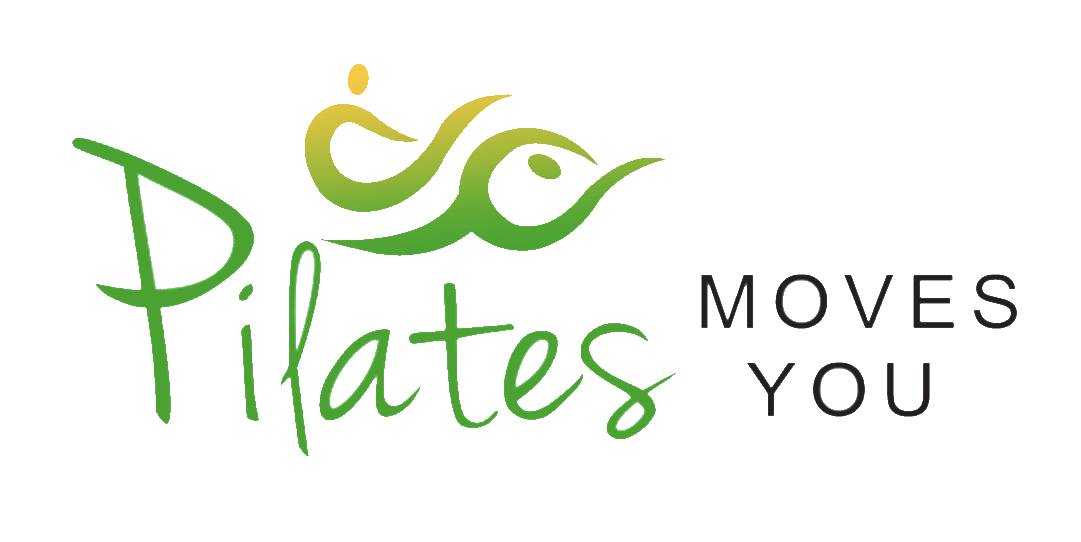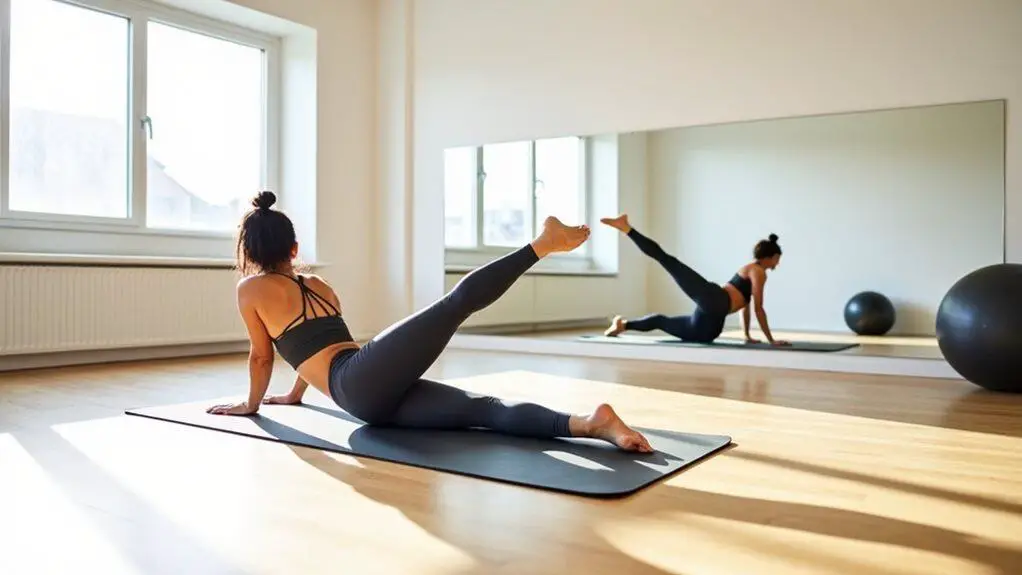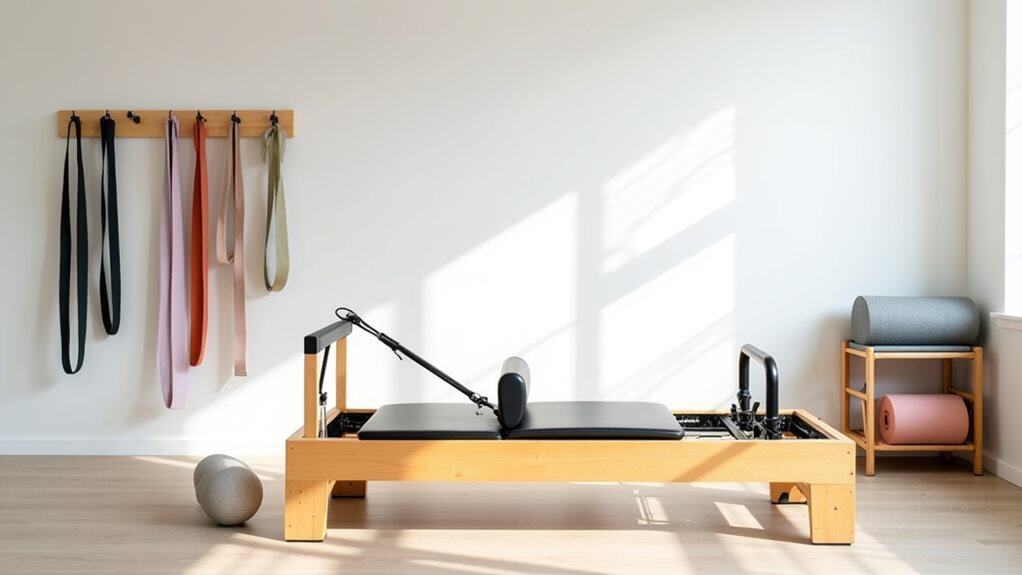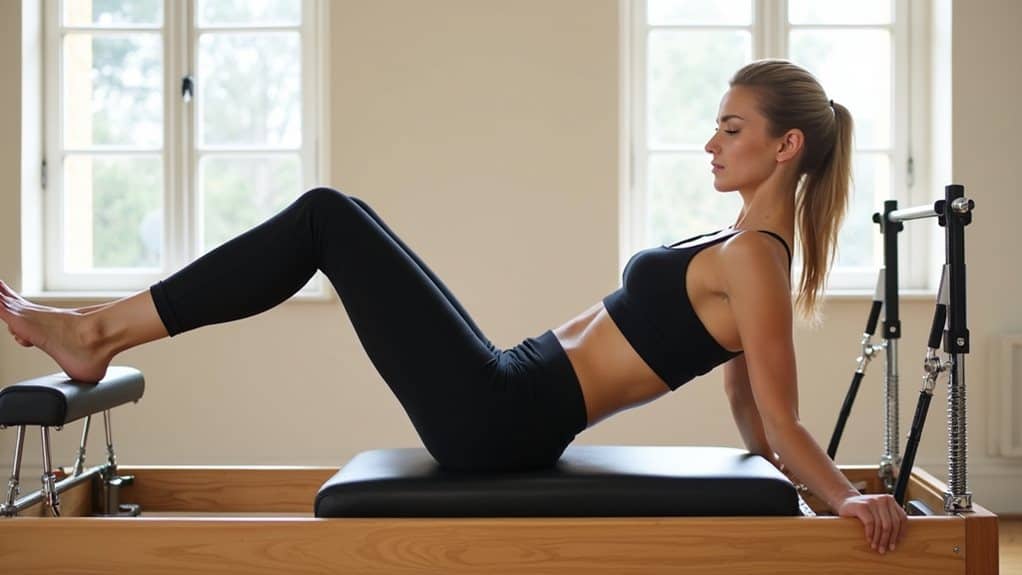Pilates is an exercise system that can be used to improve physical and mental health. It focuses on controlled and precise body movements, with the aim of increasing strength, flexibility, coordination and balance.
Pilates helps improve balance by focusing on core strength, stability, and body awareness. The exercises in Pilates target the deep stabilizing muscles of the core, including the abdominal and back muscles, which play a crucial role in maintaining balance. By strengthening these muscles, Pilates helps improve overall stability and control, making it easier to maintain balance during everyday activities.
Pilates exercises often incorporate movements that challenge balance, such as standing on one leg or performing exercises on unstable surfaces, further enhancing balance skills.
Pilates is a great way to improve coordination. It helps you become more aware of your body position and strengthens your core muscles for better movement. In this article, we will explore how Pilates can help improve your balance.
1. Strengthen the Core and Back Muscles
Understanding the importance of your core and back muscles in maintaining your balance can transform your everyday movements. Turning to Pilates provides a clear, step-by-step guide to strengthening these muscles.
Firstly, Pilates targets your abdominals, key in building a strong core. Incorporate exercises like leg circles and double leg stretches to activate these muscles. Additionally, it conditions your spine muscles. Try roll-ups for deep spinal stretching and strengthening.
Next, Pilates focuses on engaging your deep pelvic floor muscles. Ball squeezes help here. Remember to couple these exercises with optimal breathing patterns to make them even more effective. Finally, increase your flexibility and range of movement with exercises like spine twist and swan dive.
Regular practice of these Pilates exercises will strengthen your core, improve your balance and enhance your overall health. It’s a journey worth taking!
2. Improved Coordination and Balance
Pilates is an exceptional training regime aimed at enhancing your posture, balance, and coordination. It fosters control through slow, mindful movements, aiding in strengthening your body’s connection to its various parts. A brighter spotlight on Pilates will help you unravel how it boosts coordination and balance in a powerful way.
Here’s how Pilates can improve balance and coordination:
- Encourages mindfulness: Promotes sharper focus on body movement, enhancing balance.
- Upgrades flexibility: Improved suppleness augments balance and coordination.
- Strengthens core: A robust core underpins better stability.
- Trains your proprioceptive sense: Pilates enhances your body’s instinctive sense of itself, aiding coordination.
- Enhances muscle symmetry: Equal muscle strength on both sides leads to better coordination.
- Develops deep muscle: These exercises work on deeper muscles, which results in improved balance.
- Improves joint stability: Increased stability leads to better coordination.
- Better endurance: Increased stamina equals less fatigue, leading to better balance.
- Mind-Body Connection: Acknowledging this link leads to heightened coordination.
- Reduces risk of injury: Enhanced coordination leads to lower injury likelihood.
Each Pilates training session is a step towards improved balance and coordination. Practice continuously and mindfully for the most effective results. Enjoy the journey to a balanced you.
3. Strengthened Gluteus Maximus and Thigh Muscles
Your gluteus maximus and thigh muscles are key players in your balance and posture. Strengthening them through Pilates can greatly enhance your stability.
Pilates targets your deep abdominal muscles and focuses on allowing them to contract and release – a key attribute of strength. With persistence, you’ll realize improved balance and core strength.
4. Improved Body Awareness and Stability
Pilates isn’t just an exercise regimen; it’s a powerful tool to enhance body awareness and stability. It could be your pathway to better balance, a stronger core, improved posture, and even prevention of overeating.
Our bodies are complex and fascinating entities. Sometimes, we take for granted how our bodies operate and the intricate coordination required for even the simplest of movements. Pilates encourages us to engage with our bodies in a new way, enhancing our understanding of how our bodies move and function.
The practice of Pilates involves slow, controlled movements that require a great deal of focus. This concentration on movement allows us to develop a deeper connection to our bodies. We become more aware of how our bodies feel, how they move, and how they respond to different physical situations.
The enhanced body awareness developed through Pilates translates into improved stability. Pilates focuses on strengthening the core, which is the body’s center of gravity. A strong core is essential for maintaining balance and stability. As we become more aware of our bodies and strengthen our core, we naturally improve our stability.
Consistent practice twice or thrice a week makes a difference. You can start by exploring asymmetrical load exercises, where one side of your body supports while the other works, strengthening the brain/body response. A tip from Kailin Collin, a physical therapist at a Harvard-affiliated hospital, is that boosting your core strength significantly enhances balance. Enjoy the transformative journey with Pilates!
5. Improved Breathing and Concentration Skills
The benefits of Pilates go beyond physical fitness. The increased body awareness and stability also contribute to mental and emotional well-being. As we become more in tune with our bodies, we also become more grounded and centered in our minds. We can better manage stress, improve our focus and concentration, and cultivate a greater sense of inner peace.
Pilates, a mind-body practice, can significantly improve your breathing and concentration, thereby enhancing balance and overall body awareness. By focusing holistically, you’ll sharpen your mind-body connection, promoting stability and precision throughout your movement.
- Start with Concentration: In Pilates, focusing on your entire body ensures fluidity and smooth transitions between movements. The trick is to remain fully absorbed during each exercise, paying attention to both the techniques and their execution, rather than the exercise itself.
- Establish Control: It’s not about pacing through numerous reps, but mastering each movement with precision and control. Remember, you’re in charge – your body follows your command.
- Centre Yourself: Your ‘powerhouse’ – encompassing your abs, back, hips, and inner thighs – is your start and end point. All exercises should stem from this central point, promoting balance.
- Embrace the Flow: Allow one exercise to seamlessly blend into the next, building strength and stamina. The transitions matter just as much as the individual exercises.
- Breathe: Vital to your routine, synchronize your breathing with your movements. Focused exhales during exertion and deep inhales on the return can amplify your connection to the exercise.
Remember, with regular practice, Pilates doesn ‘t just enhance your physical stature. It strengthens your mind-body connection, making you more conscious and in control of every movement. With this increased awareness and concentration, you’ll find your balance significantly improved, even outside your Pilates session.
6. Increased Cardiovascular Endurance
Stretching out on a Pilates mat, you’re not just improving flexibility—you’re building cardiovascular endurance and balance. These are key components necessary to elevate your everyday activities or improve athletic performance.
Cardiovascular endurance refers to the ability of your heart and lungs to supply oxygen-rich blood to the working muscle tissues and the capacity of the muscles to use oxygen to produce energy for movement. It’s a critical aspect of overall fitness and health, impacting everything from your stamina to your risk of cardiovascular disease.
Pilates, at its core, is a form of resistance training that helps to improve cardiovascular endurance. The movements in Pilates, while often slow and controlled, are continuously challenging the muscles, which in turn requires a consistent supply of oxygen. This demand for oxygen forces the heart and lungs to work harder, thereby improving cardiovascular function over time.
Certain types of Pilates exercises, especially those performed on a reformer or other Pilates machine, can be quite physically demanding and can elevate the heart rate. This type of Pilates, often referred to as cardio Pilates, combines the traditional elements of Pilates with a more intense workout, thereby offering an excellent way to improve cardiovascular endurance.
Pilates places a strong emphasis on controlled breathing. Proper breathing is an integral part of any cardiovascular exercise, as it ensures that your muscles receive the oxygen they need. The breathing techniques taught in Pilates can help to improve lung capacity and efficiency, further enhancing cardiovascular endurance.
Pilates also contributes to better cardiovascular health by promoting relaxation and stress relief. It’s well documented that chronic stress can negatively impact heart health, increasing the risk of hypertension and heart disease. The mindful, focused nature of Pilates can help to reduce stress levels, thereby supporting heart health.
7. Enhanced Muscle Awareness and Stiffness
Through regular Pilates practice, you can enhance your muscle awareness, increase stiffness, and improve balance. Such improvements in proprioception, or body awareness, are central to preventing injuries, ensuring proper posture, and enhancing overall body strength.
- Pilates focuses on mind-body integration, improving your ability to focus on sensations in your body. Enhanced body awareness safeguards against overeating and prevents injuries, as you become sensitive to your body’s needs and responses. This heightened sense of self is vital in maintaining balance and avoiding falls.
- Pilates exercises help combat the onset of poor posture and limited mobility common in seniors. Regular practices can strengthen your spinal and trunk muscles for upright posture, and lower body work can improve ankle mobility. These preventive steps ensure balance and coordination, reducing the risks of falls and immobility.
- With Pilates, you can strengthen your stomach, increase spinal stability and elongation, and build overall strength and balance. Moreover, balance and coordination can be improved even as we age, with practices such as Pilates and mindful habits forming a part of your daily routine.
- Enhancing muscle awareness and stiffness through Pilates also helps build coordinated movements. Achieving such coordination depends on successful initiation and maintenance of activities (volition), intact proprioception (perception), and precise, repetitive, physical performances to solidify memory (engram). The Method not only promotes balance but enriches your overall quality of life.
For ultimate results, consistently incorporate Pilates into your weekly schedule. With regular practice, you’ll experience a noteworthy enhancement in muscle awareness and stiffness, leading to superior balance. Remember, it’s about quality, not quantity, and practicing just beneath your maximal capacity is key to optimizing overall balance and coordination.
8. Increased Flexibility and Range of Motion
Pilates is a powerful tool for enhancing your flexibility and range of motion, thereby promoting better balance. Its unique blend of strength and stretching exercises improves both muscular flexibility and joint mobility.
Flexibility refers to the ability of your muscles and connective tissues to stretch and lengthen. Range of motion, on the other hand, is the full movement potential of a joint, usually its range of flexion and extension. Both are important for overall fitness and health, contributing to better performance in physical activities, reduced risk of injuries, and improved quality of life.
Pilates, with its focus on controlled, deliberate movements, is an excellent way to enhance both flexibility and range of motion. Each Pilates exercise is designed to stretch the muscles, making them more flexible and less prone to injury. By regularly engaging in Pilates, you can help your muscles to become more pliant, leading to improved flexibility over time.
In addition to stretching the muscles, Pilates also targets the joints and helps to improve their range of motion. Many Pilates exercises involve movements that take the joints through their full range of motion, such as the ‘hundred’ and ‘swan dive’. These exercises encourage the joints to move freely and fluidly, which can help to prevent stiffness and maintain joint health.
Here’s another suggestion to try:
- Warm-up:Start your Pilates routine with deep breaths, gradually moving your entire body in all directions and holding each stretch for at least 30 seconds. This boosts circulation and kickstarts your flexibility improvement.
- Dynamic Stretches:Add active movements like jumping jacks to your routine. Unlike static stretches, dynamic movements increase both mobility and range of motion.
- Pilates Scissor Exercise:Lie down, raise your legs, and support your hips with your hands. As you exhale, make a scissor motion with your legs. Don’t allow them to move too far or drop in front of your face. This enhances spinal stability and hamstring flexibility.
Remember, achieving optimum flexibility through Pilates takes time and consistency. So, don’t rush the process, and be sure to enjoy every minute of your journey towards a more flexible and balanced you!
9. Improved Posture and Alignment
Good posture and alignment are pivotal to maintaining balance. Pilates, focusing on whole-body alignment and balanced muscle usage, is your tool to enhanced posture and stability.
Posture refers to the position in which we hold our bodies while standing, sitting, or lying down. Good posture is the correct alignment of body parts supported by the right amount of muscle tension against gravity. Pilates is known for emphasizing proper alignment and improving posture through its focus on core strength and body awareness.
Pilates exercises are designed to strengthen the muscles that help to keep the spine in alignment, including the abdominals, the lower back muscles, and the muscles around the neck and shoulders. By strengthening these muscles, Pilates can help you maintain a tall, upright posture, even when you’re not actively thinking about it.
Here are five ways Pilates can elevate your posture and alignment:
- It encourages body awareness, so you’re more conscious of your posture (1).
- Concentrating on core muscle strengthening, it ensures adequate support for good posture (2).
- Pilates exercises such as roll-up, roll-over, or the hundred enhance stability and spinal alignment (3).
- It corrects muscle imbalances, thereby promoting balanced posture (4).
- Regular Pilates leads to alignment consciousness even during everyday activities, ensuring continuous posture improvement (5).
One of the key principles of Pilates is ‘centering’, which involves focusing on the body’s core (the area between the lower ribs and pubic bone). This promotes strong and balanced muscles, enabling you to maintain proper alignment and posture. The controlled, precise movements in Pilates also help to improve body awareness, allowing you to become more aware of your posture and correct it when necessary.
Pilates exercises often involve moving the body in different planes of motion, which can help to correct imbalances that may contribute to poor posture. For example, exercises such as the ‘spine twist’ and ‘side bend’ can help to correct any imbalances in the muscles surrounding the spine, leading to improved posture over time.
Remember, consistency and mindfulness are key. So, engage with Pilates to embark on your journey towards improved posture and balance.
10. Increased Mind-Body Connectedness
Pilates can deepen your mind-body connection and improve balance like nothing else. This practice doesn’t only work your body, but also enhances your mental focus.
Pilates hones your awareness, making you more attuned to your body’s signals and environment. This heightened proprioception can prevent falls and injuries.
Pilates also increases cardiorespiratory capacity, stimulating feel-good hormones and improving blood flow. The low-impact nature of Pilates won’t tire you out but instead leaves you energized.
Find a well-qualified instructor, as they’ll guide you in understanding and appreciating the intricacies of your body and its abilities. Always remember to consult your doctor before starting any new exercise regime.
Final Thoughts
In conclusion, Pilates is a form of exercise that can be beneficial for physical health and daily activities. It is a full body exercise program that can be adapted to any fitness level, making it accessible to people of all ages and abilities.
Pilates can help improve posture, balance, coordination and awareness in daily life. Furthermore, its low-impact exercises make it an ideal form of balance exercise for those with joint pain or mobility issues.
With regular practice and proper guidance from an instructor, Pilates can greatly enhance your physical health and wellbeing.
Sources
https://www.semanticscholar.org/paper/d48db5cbaa8c4e6c4d802e7e692e92bc54f9a69a




